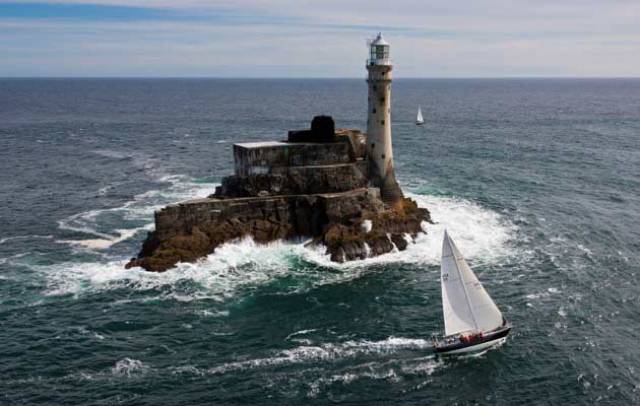The maritime pageantry which is the sequenced start of the biennial Rolex Fastnet Race gets underway in time-honoured fashion at 12.30 hrs off Cowes today. And in the almost ludicrously varied 390-plus fleet, there are some sailing machines which are so fast they’re said to be the quickest things since the notion of sailing speed was invented writes W M Nixon.
These four specials of the day are the Ultime trimarans from France, which may have first appeared in prototype form in 2017, but since then have been much worked upon, and now they’re 100ft long and look to be damn nearly as wide as that too, while their full speed potential is out of sight.
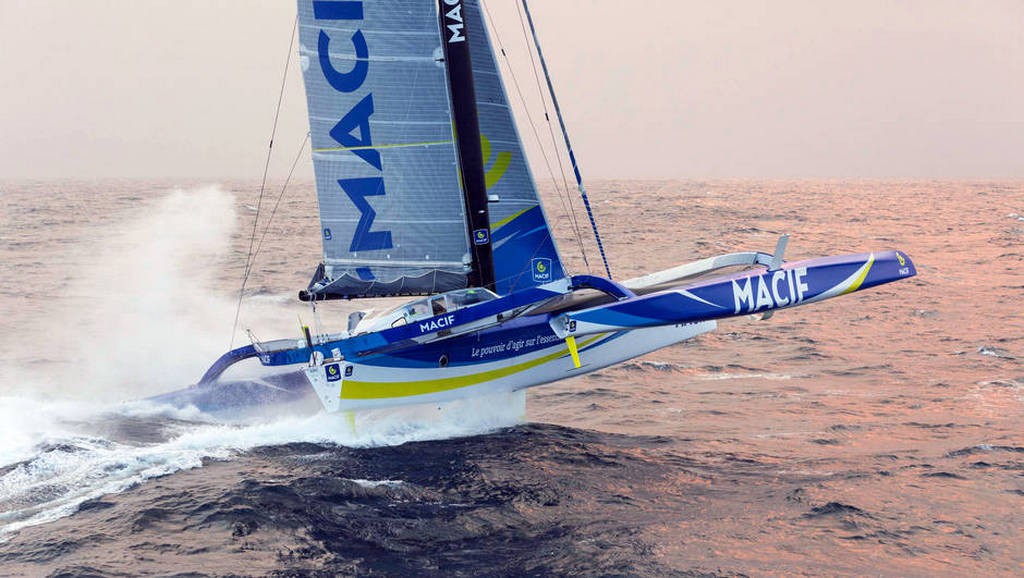 The 24-hour Fastnet Race is within her range of possibilities – the 100ft foiling trimaran Macif, skippered by Francoise Gabart, will start the Fastnet Race at 1230 hrs today
The 24-hour Fastnet Race is within her range of possibilities – the 100ft foiling trimaran Macif, skippered by Francoise Gabart, will start the Fastnet Race at 1230 hrs today
Not that most of the competitors will get much chance to see them. They take up so much space they’re not going to berth in Cowes beforehand, but will simply cross the Channel from France, come through the start line at Cowes with their fellow-multihulls first of all classes at 1230, and then after finishing at Plymouth they’ll just head straight back to France without their crews setting foot ashore.
Their magic ingredient – apart from the off-the-wall design and general hugeness in every direction – lies in the fact that they’ve brought offshore foiling technology along to a new level, and if everything holds together, we’re looking at low-flying aircraft rather than high-sailing boats.
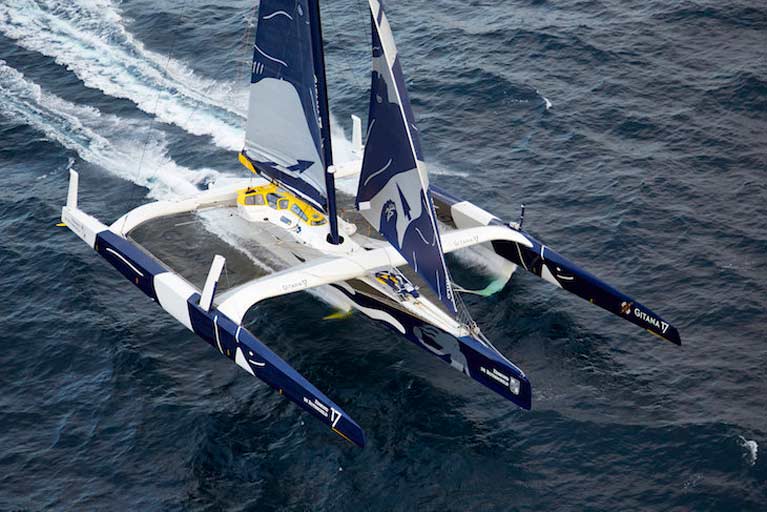 So where would you find the space to park them in Cowes before the Rolex Fastnet Race 2019? The Ultime 32s are leaving their special berths in France directly for the start line in Cowes, then they’ll race round the Fastnet Rock to Plymouth, and then they’ll head straight back to France without their crews setting foot ashore.
So where would you find the space to park them in Cowes before the Rolex Fastnet Race 2019? The Ultime 32s are leaving their special berths in France directly for the start line in Cowes, then they’ll race round the Fastnet Rock to Plymouth, and then they’ll head straight back to France without their crews setting foot ashore.
So much so, in fact, that it isn’t entirely beyond the realms of possibility that - with all the ducks in a row - an Ultime could go round the 608-mile Fastnet course within 24 hours, and it will be between Yves de Blevec’s Actual Leader (now there’s a name to flaunt at the fates), Francois Gabart’s Macif, Franck Cammas & Charles Caudillo’s Maxi Edmond de Rothschild, and Thomas Coville’s Sodebo Ultim 3 to see which of the Ultim 32/23s best does the business.
Certainly they should be at The Rock by tomorrow morning. For although the wind expectations are reasonable for the first 24 hours, with winds tending to be southeasterly in the English Channel and south to southwest beyond Land’s End for the haul across to the Fastnet, there’s a possibility of the breeze going light in the Lizard/Land’s End area. And of course the modern Fastnet course - while still reflecting the race as sailed back at its inauguration in 1925 by the likes of Harry Donegan of Cork with his 17-ton gaff cutter Gull - is now bedevilled by a plague of no-go traffic separation zones at significant headlands, particularly in the Land’s End-Isles of Scilly area where many a Fastnet Race has been won or lost.
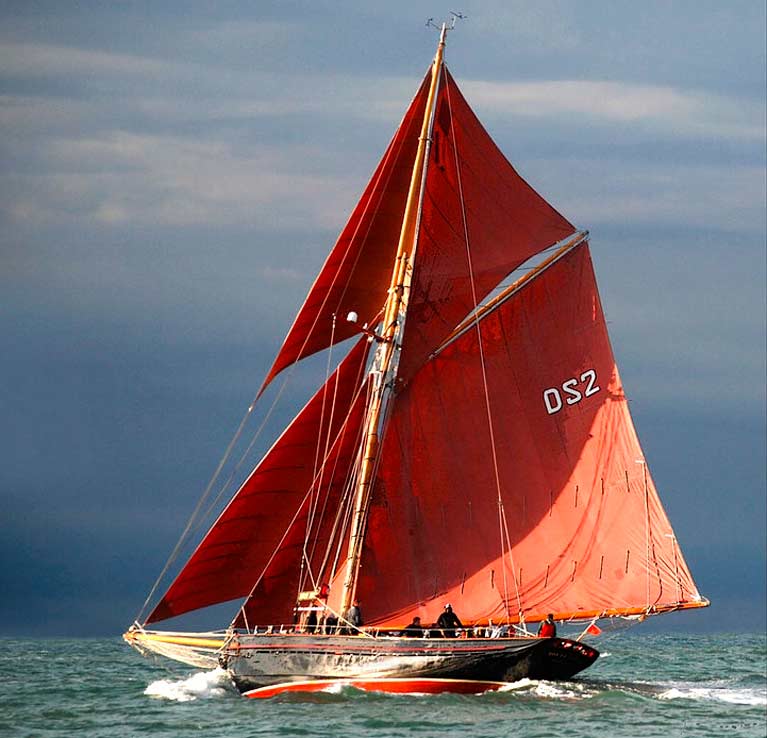 The former French pilot cutter Jolie Brise was the winner of the first Fastnet Race in 1925 when owned by George Martin. When he bought her, the advent of steam-driven pilot boats had made her redundant, and it could be argued that the introduction of the new-style offshore racing was the saving of Jolie Brise. Today, she still sails under the ownership of Dauntsey’s School
The former French pilot cutter Jolie Brise was the winner of the first Fastnet Race in 1925 when owned by George Martin. When he bought her, the advent of steam-driven pilot boats had made her redundant, and it could be argued that the introduction of the new-style offshore racing was the saving of Jolie Brise. Today, she still sails under the ownership of Dauntsey’s School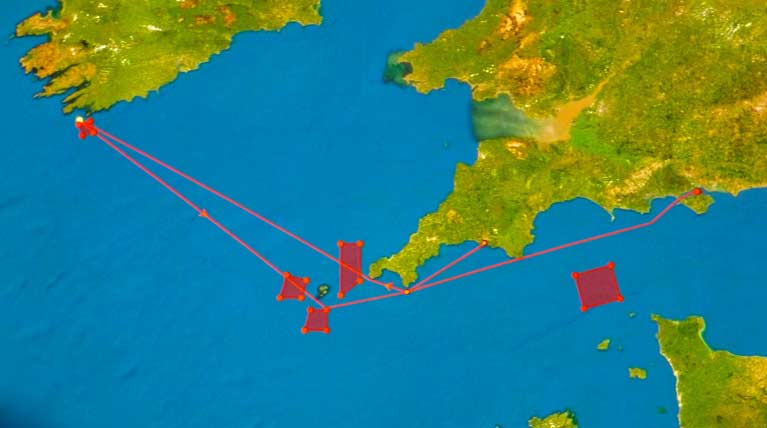 The theoretical basic course of the Fastnet Race reflects its original form, but the modern imposition of no-go Shipping Traffic Separation Zones has made the key area around Land’s End and the Isles of Scilly into even more of an obstacle race than it was already.
The theoretical basic course of the Fastnet Race reflects its original form, but the modern imposition of no-go Shipping Traffic Separation Zones has made the key area around Land’s End and the Isles of Scilly into even more of an obstacle race than it was already.
Time was when all you had to do was avoid hitting the land and the nearest boat and go straight and as fast as you could. But these days you have to work out in advance which side to go on these vast invisible areas of the TSZs, and it has added an enormous tactical extra which affects boats of all sizes.
For instance, in the previous race in 2017, Alex Thomson and Nin O’Leary in the IMOCA 60 Hugo Boss never really recovered from opting to go eastward of the big TSZ running north from Land’s End, whereas Jean-Pierre Dick clung determinedly to a more westerly course despite the IMOCA 60’s reluctance to indulge in a dead beat, and it paid him in spades.
But that was then, this is now, and though there’s an incredible IMOCA 60 entry of 20 boats, it’s those pesky Ultimes which will initially draw all the attention, even if the predicted weather pattern looks to suit the IMOCA 60s much better than the outward windward slug which dominated 2017’s race.
But then, as the froth of the flying machines settles down, we’ll find ourselves concentrating into proper contemplation of the real Rolex Fastnet Race - the hundreds of solid IRC-rated boats which know they’re going to be a sea for more than a day or two, and may well end up experiencing entirely different weather from that of the here today, gone tomorrow giants at the front of the fleet.
For the likelihood is that it’s out of their ranks that the overall winner will appear, even if Actual Leader has gone to the trouble of getting IRC-rated (it’s 2.155, which may mean she’ll almost have to be already finished at Plymouth before some of the smaller boats have passed it while heading west) together with two of the IMOCA 60s (they’re “only” 1.734), all the MOCRA class, and eight of the 22 Class 40s.
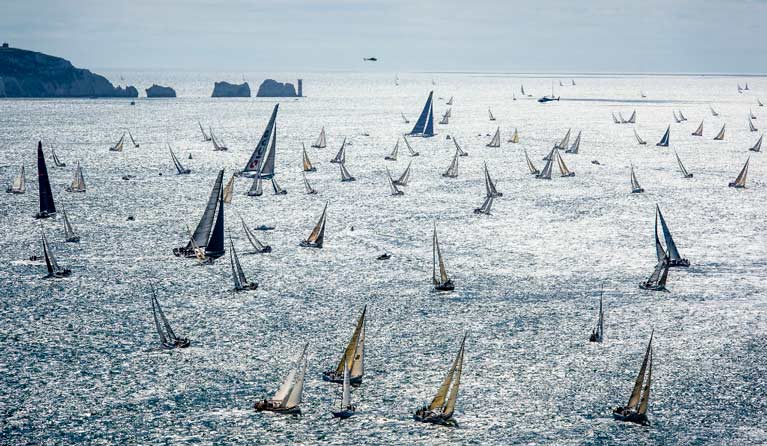 The Fastnet fleet beating towards the Needles as they exit the Solent. The IRC system is remarkably successful at extracting an overall winner from such a diversity of boats. Photo: Rolex
The Fastnet fleet beating towards the Needles as they exit the Solent. The IRC system is remarkably successful at extracting an overall winner from such a diversity of boats. Photo: Rolex
These figures are stratospheric by comparison with the numbers which affect most of the Irish sailors through the fleet, who are to be found on boats from the Emerald Isle, but have also gone international – for instance, Kenneth Rumball of Dun Laoghaire is continuing his successful link-up with the Swedish Ker 40 Keronimo in Class 1, which rates 1.198, 14 points above the 1.186 of Conor Doyle’s Xp 50 Freya from Kinsale, so there’s a duel to watch.
Graham Curran of UK Sailmakers in Crosshaven is taking the vintage route, he’s sailing on the classic S&S-design of 1966, the Swan 36 Finola and they did well in the recent Channel Race. She’s owned by Chris Frost, and they rate way down in the basement at 0.901, which is even lower than the 0.919 of Foynes’ Conor Dillon in the two-handed division in the Dehler 34 Big Deal, and the 1.003 of Kinsale’s Cian McCarthy (also two-handed) in the X362 Eos.
In complete contrast, Conor Fogerty of Howth with his foiling Beneteau Figaro 3 Raw has a punitive rating of 1.124, which puts him into the 63-strong Class 1. The foils on these new boats are a mixed blessing, as Fogerty tells us they only begin to confer any sort of performance benefit when the wind gets up to 15 knots, and it isn’t until 20 knots of wind that you really begin to do the business.
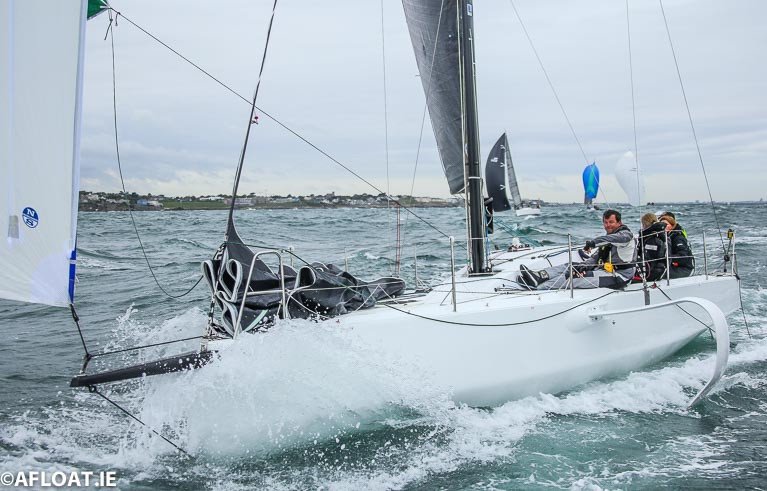 Conor Fogerty’s Beneteau Figaro 3 Raw – she needs 15 knots of wind for the foils to start working effectively and requires it to be hitting 20 knots if she is to sail up to her punitive rating of 1.124. Photo Afloat.ie/David O’Brien
Conor Fogerty’s Beneteau Figaro 3 Raw – she needs 15 knots of wind for the foils to start working effectively and requires it to be hitting 20 knots if she is to sail up to her punitive rating of 1.124. Photo Afloat.ie/David O’Brien
Thus the reality seems to be that the most satisfying boat for a Figaro 3 to race against is another Figaro 3, but although another privately-owned sister-ship was reputedly going to enter, there’s none showing up on the listings, and Raw seems to be on her own, finding that her closest contenders rating-wise in Class 1 include Michael O’Donnell’s J/121 Darkwood, winner of the recent Channel Race, and Andrew Hall’s sister-ship Jackhammer from Pwllheli.
Despite the cards being stacked against him, Conor Fogerty has put together a strong crew of four, as his main helm is Howth’s Laura Dillon who was the first woman to win the All-Ireland championship, together with Figaro racer Joan Mulloy of Mayo, and Corby 25 racer Denis Coleman of Cork.
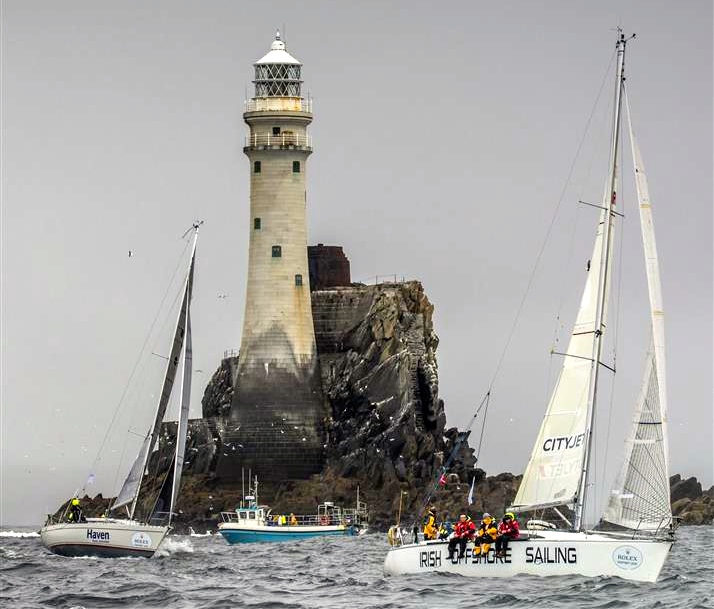 Irish Offshore Sailing’s Desert Star on her way to winning the Roger Justice Trophy in the 2015 Fastnet Race. A regular participant, Desert Star is back this year again under the continuing command of Ronan O Siochru. Photo: Rolex
Irish Offshore Sailing’s Desert Star on her way to winning the Roger Justice Trophy in the 2015 Fastnet Race. A regular participant, Desert Star is back this year again under the continuing command of Ronan O Siochru. Photo: Rolex
It says much about the demographics of modern Ireland that for the past two Fastnets, our most successful boats have come from Offshore Sailing Schools, which have their race within a race for the Roger Justice Trophy. Last time round, it was the Irish National Sailing School’s J/109 Jedi skippered by Kenneth Rumball which took the cup, the time before it was Ronan O Siochru with Irish Offshore Sailing’s Jeanneau 37 Desert Star which is going yet again this year, her crew doubtless inspired by the last time Ireland provided the overall winner, which was in 2007 with Ger O’Rourke’s Cookson 50 Chieftain from Kilrush, an achievement which, in international terms, is right up there with Annalise Murphy’s Silver Medal in the 2016 Olympics.
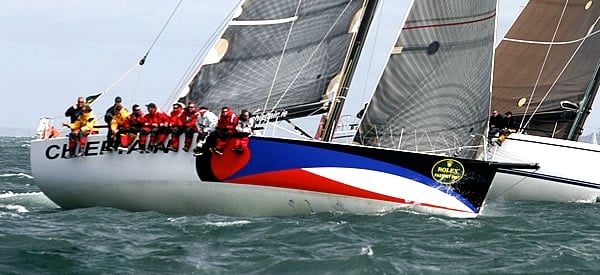 Ger O’Rourke’s Cookson 50 Chieftain from Kilrush at the start of the 2007 Fastnet Race, which she was to win overall
Ger O’Rourke’s Cookson 50 Chieftain from Kilrush at the start of the 2007 Fastnet Race, which she was to win overall
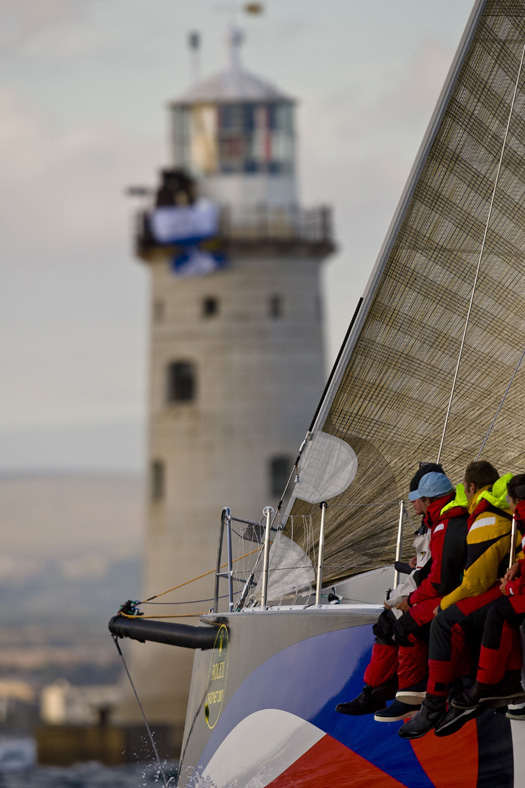 That magic moment – Chieftain at Plymouth Lighthouse, overall winner of the 2007 Rolex Fastnet Race
That magic moment – Chieftain at Plymouth Lighthouse, overall winner of the 2007 Rolex Fastnet Race
With today’s race marking the 40th Anniversary of the history-laden Fastnet Storm of 1979 (even if we are two weeks earlier), there is special interest in boats which were there forty years ago, and none is more remarkable than the vintage Contessa 32 Assent, which was last boat to finish in 1979, but as she was one of the smallest boats in the fleet, she won Class IV for her dogged persistence and heroic performance.
In fact, the Contessa 32’s reputation for ultimate seaworthiness was much enhanced by the Fastnet storm, for with her fairly low freeboard and compact form, she goes into semi-submarine mode when the sea goes crazy. Thus where high volume boats like the then-new OOD 34s (ironically also built by Jeremy Rogers) were being rolled like beach-balls, the Contessa 32 clenched her teeth and went straight through the nasty ones.
Back in 1979, Assent was owned by the Ker family, who are sheep farmers in Somerset, and it was Alan Ker who skippered her in the Fastnet. But after that his father Willie – who of all things had come to sailing through International OK dinghy racing – took over command of Assent, and started a series of ever more adventurous voyages into high latitudes which had won him international recognition and a string of major awards when he finally hung up his seaboots in his 80s.
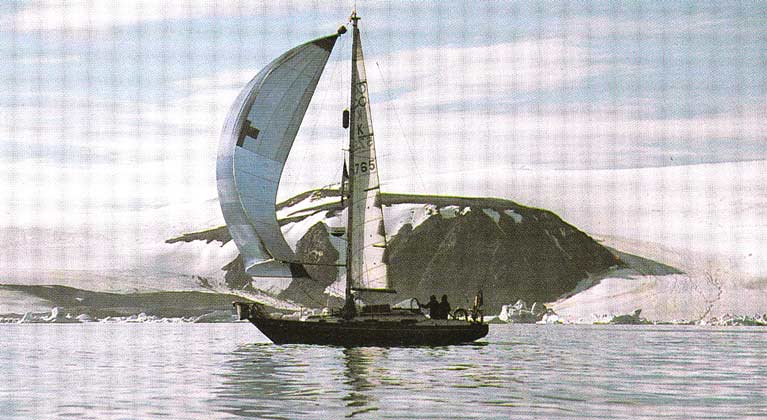 The late Willy Ker’s Contessa 32 Assent cruising in Arctic waters 850 miles from the North Pole. Assent won Class IV in the 1979 Fastnet Race sailed by Alan Ker, and she is racing in today’s Fastnet Race sailed by the Rogers family of Lymington, who built Assent and have now given her a major restoration.
The late Willy Ker’s Contessa 32 Assent cruising in Arctic waters 850 miles from the North Pole. Assent won Class IV in the 1979 Fastnet Race sailed by Alan Ker, and she is racing in today’s Fastnet Race sailed by the Rogers family of Lymington, who built Assent and have now given her a major restoration.
By that time Assent was looking distinctly tired, so the Rogers family took her over and brought her back to their yard in Lymington to give her a complete facelift, since when which she has been making her mark back on the racing circuit.
Sadly, the great Willie Ker died last month at the age of 93. But Assent is going stronger than ever, and she’ll be racing today’s Fastnet in a very special capacity in Class IV on a rating of 0.853 (the lowest in the fleet) sailed by Kit and Simon Rogers. So if at some stage during the race you see a very small but accomplished-looking blue boat with sail number GBR 5765, then you’re looking at more sailing history in one little 32ft boat than you’d think possible.
Another piece of remarkable history stepping down the Solent today is American owner Rives Potts’ 48ft Jim McCurdy-designed Carina. Not only was Carina a successful finisher in 1979’s race in her final year of ownership with the great Dick Nye who’d had two overall Fastnet victories back-to-back in 1955-57 with a previous Phil Rhodes-designed Carina, but in fact he’d made his debut with the new alloy-built Carina in the race of 1969. So today Carina is marking both her involvement in 1979, and her Fastnet Golden Jubilee from 1969, while Rives Potts has memories in every direction, as he was a crewmember aboard Ted Turner’s overall winner in 1979’s storm, the 63ft S&S design Tenacious.
If you’re into classic American offshore racers of a certain era and under-stated style, then Carina is the boat for you. She has won at least three Bermuda Races overall, and though she hasn’t had a Fastnet overall victory yet, on her last visit in 2011 she won her class, providing the definitive Fastnet-rounding image just ten hours after George David’s Rambler 100 had lost her keel in very different conditions at the same spot.
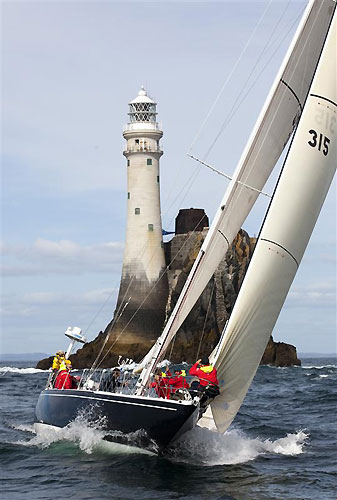 American classic. The Jim McCurdy-designed 48ft Carina (Rives Potts) is a significant presence in the Fastnet Race story. Photo: Rolex
American classic. The Jim McCurdy-designed 48ft Carina (Rives Potts) is a significant presence in the Fastnet Race story. Photo: Rolex
George David is of course back with the all-conquering Rambler 88, and the battle for mono-hull line honours at the front of the fleet is going to be quite something, but maybe he’ll find a minute for a quick salute to his old friends on the Baltimore Lifeboat crew as he rounds The Rock, for it’s possible they’ll be there aboard The Robert, Baltimore’s 1979 Watson 47 lifeboat which has been restored by Jeff Houlgrave.
Out of all this cornucopia of historic and modern boats, an overall IRC winner has to emerge in due course, and for the last three Fastnets, that very special role has been filled by a French boat. So it’s surely time for some other nation to get a look-in, and with dozens of countries sending forth crews, the possibilities are almost endless. But then, waiting and watching to see who finally comes out on top is part of the global fascination that this “Race of Races” attracts.
Race tracker here




























